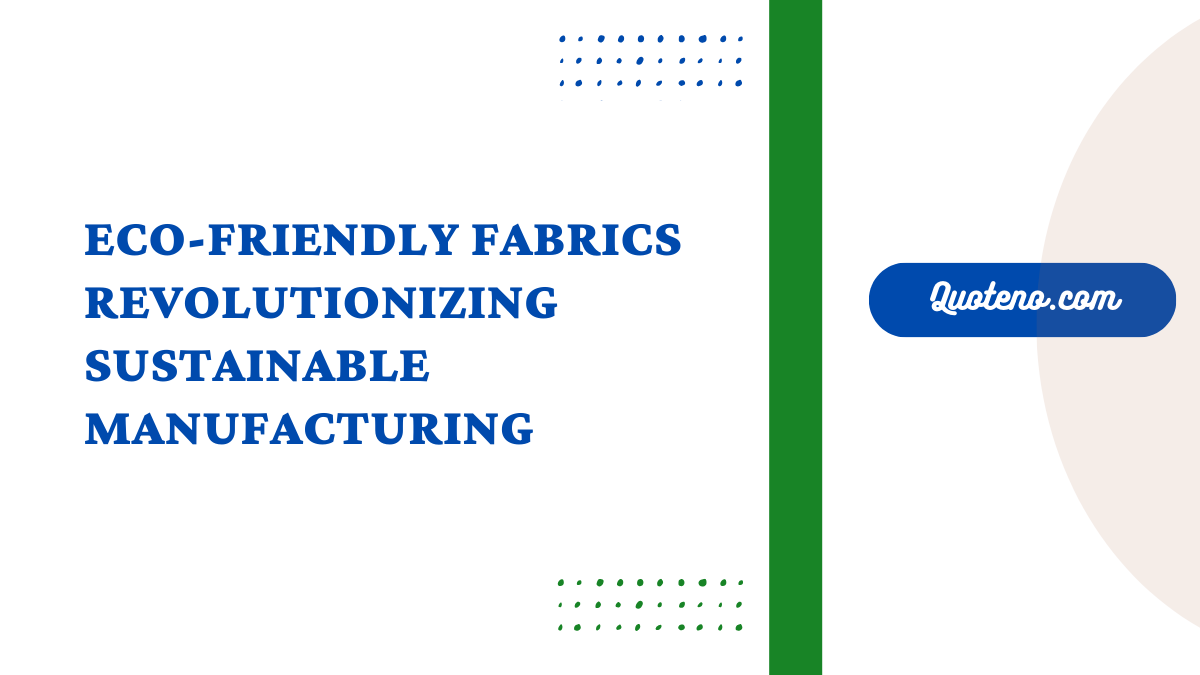Eco-friendly fabrics are sourced from nature and produced without harmful chemicals. They require less water and pesticides to grow and no chemical dyes or bleaching.
Whether you’re a designer, seamstress, or fashion lover, switching to sustainable fabric is one of the best ways to decrease environmental impact. Here are some of the best eco-friendly materials to choose from:
Table of Contents
Organic Cotton
A growing demand for sustainable clothing and home textiles has driven the organic cotton revolution. Organic cotton is grown without synthetic fertilizers and pesticides, which reduces soil pollution. It also uses less water during cultivation. This makes it an excellent alternative to conventional natural fibers.
Moreover, the organic crop helps preserve biodiversity and protects farmers’ health. Organic farming reduces greenhouse gas emissions and promotes carbon sequestration by using natural methods to maintain and replenish soil nutrients. Furthermore, it reduces eutrophication, which is the buildup of excess nutrients in bodies of water that can kill fish and other organisms.
Additionally, the farmers who grow organic crops are constantly curating their seed stock and saving seeds from their best-performing crops. This allows them to continue producing high-quality, non-GMO cotton that can meet various consumer needs for decades. The fact that they don’t rely on commodity markets to sell their cotton means that the price is higher, but it’s more than enough to support farmers and their families while protecting the environment.
In addition, an environmentally friendly manufacturing that produces organic cotton fabrics must follow strict requirements that ensure the material is free from harmful chemicals. For example, a garment must have certified organic cotton for GOTS certification. This makes it easier for consumers to make ethical choices.
Bamboo
Bamboo is considered the ninja of sustainability, as it reaches new heights using minimal resources. It’s naturally antibacterial, breathable, and absorbent, making it ideal for clothing. In addition, it’s a renewable resource that proliferates and requires no fertilizers. Bamboo also has a lower water footprint than cotton. It’s no wonder that sustainable brands are incorporating this remarkably versatile material into their collections.
One of the most impressive aspects of bamboo is that it can grow in almost any environment, including arid regions and cool mountainous areas. It’s even able to adapt to its surroundings by growing tall and erect or bushy and clumping. Moreover, many clumping bamboo species can be developed as an effective windbreak around crops or as a fence.
To make fabric out of bamboo, it must be processed, which can be done traditionally to create bamboo rayon or through a process known as “lyocell.” The latter method uses much less chemicals than conventional viscose. This process also uses fewer old-growth trees. It’s essential to check the label when choosing bamboo fabrics to ensure the garment is eco-friendly. The best part is that bamboo fabric feels as soft and smooth against your skin as cotton! It also dyes beautifully and holds its colors well.
Hemp
Although often associated with marijuana, hemp is a plant that offers many eco-friendly properties. As a bast fiber, it can produce fabrics “ranging from jerseys to denim to hessian to canvas.” Hemp is also naturally insulating, which makes it an excellent material for clothing and other textiles. Additionally, it is incredibly durable and breathable. It can also make hemp wool, perfect for knitwear, and soften to a natural linen-like texture after washing.
When it comes to sustainable manufacturing, choosing the suitable fabric is an essential factor. By using eco-friendly materials, manufacturers can reduce the amount of harmful chemicals in their products. These fabrics can be woven from various sources, including organic cotton, bamboo, and hemp. Hemp is a hardy crop, requiring minimal water and no pesticides. Additionally, it is a fast-growing plant and can produce up to 2.5 times more fiber on the same land area as cotton.
It is also a highly biodegradable material that breaks down quickly when recycled or thrown away at the end of its lifecycle. Many companies embrace hemp as a new raw material for high-performance fabrics with unique characteristics. These include antimicrobial, electrical, and mechanical properties. Hemp also absorbs carbon dioxide more efficiently than most crops and trees.
Recycled Cotton
Recycled cotton, or upcycled cotton, is made from repurposed textile waste. It can be produced sustainably with a lower carbon footprint than conventional cotton. Growing requires less water, energy, pesticides, fertilizers, and land. It can be made into a high-quality clothing fabric that is as good as new ones and has the added benefit of keeping discarded clothes out of landfills.
This fabric is usually produced by recycling charities and companies from second-hand clothing donated to them. The shredded fibers are then sorted and spun into yarns before being used to make new fabrics. Recycled cotton can be combined with other materials to guarantee quality and strength. The best brands of recycled cotton can often be certified as GRS-certified, meaning they are third-party-certified for chain of custody, social and environmental practices, and chemical restrictions.
Recycled cotton does not need any chemicals to be cultivated, so it is significantly less harmful to the environment than organic or regular cotton. It also requires less water to produce a single garment than conventional cotton. One ton of recycled cotton can save up to 765 cubic meters of water. In addition, it has ten times less CO2 than traditional cotton. The fashion industry uses a lot of water and energy to manufacture fabrics, so eco-friendly materials are an excellent way to reduce these costs while still providing stylish, quality clothing.

